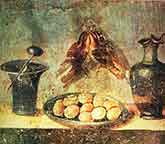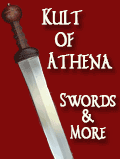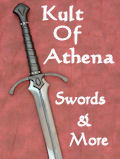Recipe for
Tyros eis Halmen
(Pickled Cheese)

by Cassianus Bassus, Geoponica (Country Matters)
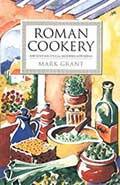
Roman Cookery: Ancient Recipes for Modern Kitchens.
Yes, this book has a new cover, but I like this one better. Blah, I am so horrible.
Cassianus Bassus (c.600) is traditionally credited with assembling a 20 volume agricultural treatise called Geoponica which translates as SCountry Matters or agricultural pursuits. In the text of the section on cheese noted by Grant, there are multiple references to ways to make cheese last longer including smoking, mixed with honey, sea/salt water, and stored with grain in addition to pickling.
Cheese was a staple for country and city people. Most cheese was from goat's or sheep's milk. Bassus notes a preference for goat milk for making cheese.
Among the oldest cheeses in the Roman world is "conciato romano", an ancient cheese, made of a mix of fresh raw sheep, cow and goat milk from Castel di Sasso in the province of Caserta that dates back to the ancient Samnites, centuries before Christ: some say it is the oldest of all Italian cheeses.
In the city, cheese was served both for breakfast and dinner; as well as being available as part of the mid-day meal. At dinner, it was usually part of the Gustum or appetizer course. There are numerous recipes for making cheese in various forms from the freshest to the hard dried cheeses. Several of the softer cheese recipes have additions of oil and herbs for flavoring and were eaten with bread; cold or heated. A favorite was fresh curds flavored with herbs and oil. It is mentioned in several texts and several of the Roman cookery texts give recipes for it; including Apicius (8th C.).
In ancient Rome, vinegar was made from wine that had gone flat or that had been fermented with additional yeast, salt and honey. It was used to preserve fruits, vegetables and fish. Modernly, vinegar soaked wrappings of cheesecloth are used to inhibit mold during cheese storage and give it a longer shelf life. Honey was used as a major flavoring in Roman times for both foods and wine. This recipe calls for sweet wine vinegar. In Columella's text, Flower notes the proportion is given as oz. of honey to a pint of wine for a sweetened wine drink. While this is for a drink, many recipes use honey quite liberally. This gives us an indication that they liked well sweetened foods. Honey is also used as a preservative for fruit — coating the fruit in honey and then storing it is mentioned in several different texts.
Thougts on Ingredients (from Bayrose.org)
- Feta >>> —
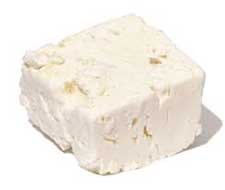 this cheese is noted as being able to be handled, washed and
dried. Sheep and/or goat feta is available. Also the cheese needed to be of a type that would spoil
relatively quickly without further steps being taken. Feta meets all these requirements.
this cheese is noted as being able to be handled, washed and
dried. Sheep and/or goat feta is available. Also the cheese needed to be of a type that would spoil
relatively quickly without further steps being taken. Feta meets all these requirements. - Savory or Thyme, the herbs are specified, but not the amounts. 1 oz of fresh herb sprigs is a substantial quantity, several tablespoons worth. Thyme was easily available in the stores and my savory was not ready to harvest.
- Vinegar and Honey, the original talks about sweet wine vinegar which we know is sweetened with honey during the fermentation process OR vinegar and honey. If the vinegar is sweetened with honey during fermentation, it probably is not super sweet, but rather lacks the bite commonly associated with vinegar. If honey is added to vinegar, no amount is specified in the original. I chose to add enough honey to white wine vinegar, to take out some of the vinegar bite without becoming super sweet; although many of the Roman foods were fairly heavily sweetened.
- The cheese needs about a day absorb some of the flavor from the herbs and vinegar. Previous experiments show it keeps well for a couple days without refrigeration or a couple weeks with refrigeration.
*Note: While researching and looking at this recipe, I found a great pdf on a personal website that had some more info I meshed in. All good stuff. I am linking to it here: http://www.bayrose.org/recipes/index.html
Translation of original recipe: Cheese keeps after being washed in fresh water and dried in the sun, then put in an earthenware jar together with savory or thyme, each cheese separated from the other according to it strength, with the addition of sweet wine vinegar or a mixture of vinegar and honey, until the liquid rises above the cheese and herbs.
Ingredients
- 4 oz feta cheese
- ½ oz dried thyme or savory
- 2 fluid oz red wine vinegar
- ½ ounce honey
Preparation
- Wash and dry the feta cheese and cut it into 1 cm/½" inch cubes.
- Put in a layer of cubed cheese and then a layer of thyme into a clean glass jar.
- Repeat the layers until the jar is nearly full.
- Thoroughly mix the honey with the vinegar and pour over the cheese until the jar is full.
- Screw on the cap and leave to infuse for one day.
- Serve.


